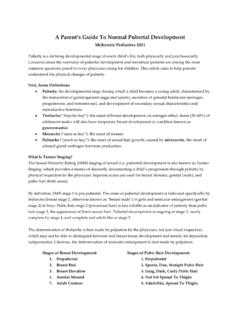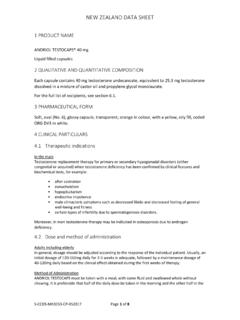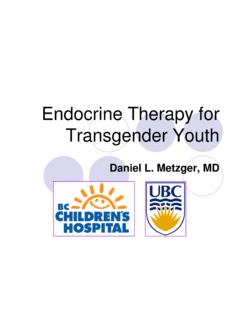Transcription of PREPUBERTAL AND PUBERTAL GYNECOMASTIA
1 PREPUBERTAL AND PUBERTAL GYNECOMASTIA Marco A. Rivarola y Alicia Belgorosky Servicio de Endocrinolog a - Hospital de Pediatria Garrahan Buenos Aires Argentina Physiology and molecular mechanisms GYNECOMASTIA is defined as the growth of the male mammary gland to become palpable and/or visible. During embryogenesis, the differentiation of the mammary gland and surrounding estroma, as well as the areola and the nipple, is similar in the two sexes.
2 It is well established that estrogens stimulate breast growth. The production of estrogens during pregnancy is very high. For this reason, breast development is frequently present at birth in the two sexes. Furthermore, several growth factors (EGF, TGF , IGF-1), progesterone, and GH have also been implicated in mammary growth. However, little is known about the mechanisms modulating differentiation and development of the mammary gland in fetal life [1]. The gonadal activity of the embryonic and fetal testes with their high secretion of testosterone do not generate a sexual dimorphism in the breast development of the newborn.
3 This is interesting, because it has been speculated that in the absence of androgen action, such as in the complete form of the androgen insensitivity syndrome, mammary over development is observed [2]. Moreover, it is generally accepted that the estrogen/androgen balance is an important factor in adult GYNECOMASTIA [3, 4], and some experimental evidence indicates that testosterone inhibits estrogen-induced mammary epithelial cell proliferation and suppresses estrogen receptor expression [5]. Even though many questions remain, the central role of estrogens and its receptors on mammary development is well accepted.
4 Estrogens are synthesized from androgens by cells containing the cytochrome P450 enzyme aromatase, which is transcribed from the CYP19 gene. Typically, these are granulosa cells of the ovaries and syncytiotrophoblast cells of the placenta. However, many other cells do also express aromatase, such as, mesenchymal cells of adipose tissue, including those of the breasts, central nervous system cells, testicular Leydig cells, etc. [6]. The CYP19 gene is located in chromosome 15q21. It has 10 exons and different promoters in different to tissues [6].
5 The coding sequence, exons 2-9 transcribes the same protein in every tissue. In men, and in post menopausal women the origin of estrogens (estradiol and estrone) is mainly extra gonadal, originating from gonadl and adrenal androgen precursors. Even though extragonadal estrogens contribute to serum estradiol and estrone, the importance of the local synthesis of estrogens is the possibility to act as a paracrine stimulation in selected targets. In PREPUBERTAL boys, after the first trimester of life, circulating estrogen levels are very low, barely detectable with the usual methodology.
6 Furthermore, sex hormones (mainly testosterone and estradiol) circulate in blood strongly bound to a specific protein, sex hormone binding globulin (SHBG). The affinity constant of testosterone for SHBG is greater than that of estradiol, and therefore, it retains testosterone in serum preferentially (lower free testosterone). Serum SHBG increases during the first trimester of life, to gradually decrease thereafter during prepuberty [7]. At puberty, there is a sharp increase in testicular testosterone secretion and a moderate increase in serum estradiol concentration (usually below 25 pg/ml even in advanced puberty and adulthood [8].)
7 Furthermore, there is a decrease in serum SHBG which might favour testosterone entrance over that of estradiol in target cells. The normal serum estrogen levels of boys in the presence of high testosterone concentrations do not usually stimulate mammary tissue development. However, a transient derangement of the equilibrium of estrogens and androgens might be present during normal puberty (see below). In target tissues, estrogens enter cells and bind to specific receptors, belonging to a family of transcription factors, to modulate gene expression in the nucleus.
8 Two different types of estrogen receptors, alpha and beta (ER y ER ), with different tissue distribution, have been described. In the last years, presence of steroid hormone receptors [9], including ERs [10], in the cell membrane has been described. In these instances the mechanism of action rather than genomic, is mediated by activating signal transduction at the membrane and rapid cell responses. Classification of GYNECOMASTIA in children and adolescents Finally, when the described mechanisms of breast development are disturbed, an excessive growth of mammary tissue might occur in males, i.
9 E. , GYNECOMASTIA . For the analysis of this clinical condition in children and adolescents, it is convenient to take into account the age of onset of GYNECOMASTIA : 1) in newborns at birth, 2) during prepuberty (from 2 months to 11 years of age), and 3) during adolescence (11- to 20-year-old boys). 1. Neonatal GYNECOMASTIA . As previously stated, newborn GYNECOMASTIA is relatively frequent, approximately 60 % [11]. It is a benign condition. It is usually resolved in a few weeks, even though it might occasionally last several months.
10 Fluid discharge from the nipple can be present. This is probably the result of the effect of hormones secreted by the feto-placental unit during pregnancy [12]. On physical examination, the two breast glands are palpable behind the areolas. They are usually symmetrical. The possibility that what is palpated is not the mammary gland is always present. It could be a abnormal nodule, particularly if it is not symmetric or with different consistency. During follow up mammary nodules should disappear. 2. PREPUBERTAL GYNECOMASTIA PREPUBERTAL GYNECOMASTIA is not frequent, but when present, it is a sign of concern.








